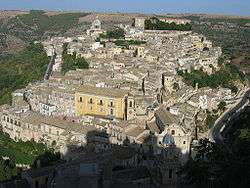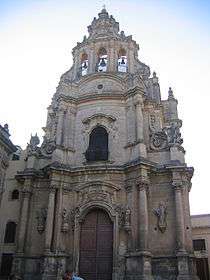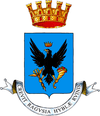Ragusa, Sicily
| Ragusa | ||
|---|---|---|
| Comune | ||
| Città di Ragusa | ||
 Panorama of Ragusa Ibla | ||
| ||
.svg.png) Ragusa within the homonym province | ||
 Ragusa Location of Ragusa in Italy | ||
| Coordinates: 36°56′N 14°45′E / 36.933°N 14.750°E | ||
| Country | Italy | |
| Region | Sicily | |
| Province | Ragusa (RG) | |
| Frazioni | Marina di Ragusa, San Giacomo Bellocozzo | |
| Government | ||
| • Mayor | Giuseppe Cassì | |
| Area | ||
| • Total | 442.6 km2 (170.9 sq mi) | |
| Elevation | 520 m (1,710 ft) | |
| Population (26 February 2018)[1] | ||
| • Total | 74,251 | |
| • Density | 170/km2 (430/sq mi) | |
| Demonym(s) | Ragusani | |
| Time zone | UTC+1 (CET) | |
| • Summer (DST) | UTC+2 (CEST) | |
| Postal code | 97100 | |
| Dialing code | 0932 | |
| Patron saint |
St. John the Baptist (Ragusa) St. George (Ragusa Ibla) | |
| Saint day | June 24 | |
| Website | Official website | |
| UNESCO World Heritage site | ||
| Part of | Late Baroque Towns of the Val di Noto (South-Eastern Sicily) | |
| Criteria | Cultural: (i)(ii)(iv)(v) | |
| Reference | 1024rev-007 | |
| Inscription | 2002 (26th Session) | |
| Area | 17.39 ha (1,872,000 sq ft) | |
| Buffer zone | 29.32 ha (3,156,000 sq ft) | |
Ragusa (Italian: [raˈɡuːza], ![]()
History
The origins of Ragusa can be traced back to the 2nd millennium BC, when there were several Sicel settlements in the area. The current district of Ragusa Ibla has been identified as Hybla Heraea.
The ancient city, located on a 300-metre (980 ft)-high hill, came into contact with nearby Greek colonies, and grew thanks to the nearby port of Camerina. Following a short period of Carthaginian rule, it fell into the hands of the ancient Romans and the Byzantines, who fortified the city and built a large castle. Ragusa was occupied by the Arabs in 848 AD, remaining under their rule until the 11th century, when the Normans conquered it. Selected as County seat, its first Count was Geoffrey, son of Count Ruggero of Sicily.
Thereafter Ragusa's history followed the events of the Kingdom of Sicily, created in the first half of the twelfth century. A Chiaramonte family fief, it remained the county capital after it was unified with Modica in 1296, a status it lost in the 15th century after a popular revolt.
In 1693 Ragusa was devastated by a huge earthquake, which killed some 5,000 inhabitants. Following this catastrophe the city was largely rebuilt, and many Baroque buildings from this time remain in the city. Most of the population moved to a new settlement in the former district of Patro, calling this new municipality "Ragusa Superiore" (Upper Ragusa) and the ancient city "Ragusa Inferiore" (Lower Ragusa). The two cities remained separated until 1926, when they were fused together to become a provincial capital in 1927 at the expense of Modica, the former capital and the most populous and important city in the region since 1296.
In 1838 an asphalt deposit was discovered, which is still being worked.
Geography
Ragusa is a hilltown that lies below the Hyblaean Mountains, and is historically divided into Ragusa Ibla and Ragusa Superiore. The municipality borders with Chiaramonte Gulfi, Comiso, Giarratana, Modica, Monterosso Almo, Rosolini (SR), Santa Croce Camerina, Scicli and Vittoria.[2] It counts the hamlets (frazioni) of Marina di Ragusa, located by the sea, and San Giacomo Bellocozzo.
Main sights
The city has two distinct areas, the lower and older town of Ragusa Ibla, and the higher Ragusa Superiore (Upper Town). The two halves are separated by the Valle dei Ponti, a deep ravine crossed by four bridges, The most noteworthy of which is the eighteenth-century Ponte dei Cappuccini.
Upper Town
Ragusa Cathedral, dedicated to Saint John the Baptist (San Giovanni Battista), is the biggest attraction in Ragusa Superiore. The church was originally located in the western part of ancient Ragusa, under the walls of the Mediaeval castle, where the small church of St. Agnese is today. A smaller building was quickly built on the site after the 1693 earthquake, which soon proved inadequate. The current edifice was built between 1718 and 1778, with a façade in typical southern Sicilian Baroque style, with three portals and sculptures representing the Madonna, St. John the Baptist and St. John the Evangelist. The upper columns have two clocks showing the time in Italian and French fashions respectively. The high bell tower, on the left side, is also in Baroque style.
The ornate Baroque interior has a Latin cross plan, with a nave and two aisles separated by three colonnades embellished with gold. Charts showing Bible verses referring to St. John the Baptist are over every column. The dome was built in 1783, and covered with copper sheets during the 20th century. The side chapels, characterized by altars decorated with polychrome marbles, date from the 19th century.
Also noteworthy is the Hyblean Archaeological Museum, with different sections devoted to archaeological finds from the Prehistoric to the Late Roman era.
Ragusa Ibla
Ragusa Ibla is home to a wide array of Baroque architecture, including several stunning palaces and churches.
The Cathedral of San Giorgio started in 1738 by architect Rosario Gagliardi, in place of the temple destroyed by the 1693 earthquake, and of which is the only place in the city a Catalan-Gothic style portal can still be seen. The façade contains a flight of 250 steps and massive ornate columns, as well as statues of saints and decorated portals. The interior has a Latin cross plan, with a nave and two aisles ending in half-circular apses. It is topped by a large Neoclassical dome built in 1820.
On a narrow winding street connecting Ragusa Ibla with Ragusa Superiore lies the church of Santa Maria delle Scale ("Saint Mary of the Steps", built between the fifteenth and the sixteenth centuries). This church is particularly interesting: badly damaged in the earthquake of 1693, half of this church was rebuilt in Baroque style, while the surviving half was kept in the original Gothic style (including the three Catalan-style portals in the right aisle). The last chapel of the latter has a Renaissance portal. The chapels are adorned with canvases by Sicilian painters of the 18th century.
- Church of the Souls of the Purgatory has a Baroque portal.
- Church of Santa Maria dell'Itria, built by the Knights of Malta in the seventeenth century, has a campanile with ceramics from Caltagirone and a canvas attributed to Mattia Preti.
- San Filippo Neri
The church of San Giorgio, designed by Rosario Gagliardi and built between 1739–1775, has a façade with tiers of juxtaposed columns. The Treasury contains silver items. Similar though smaller is the nearby church of St. Joseph, with an elliptic interior housing a seventeenth-century statue.
The church of Sant'Antonino is an example of Norman architecture, characterized by a Gothic portal, while the Church of Immacolata boasts a fine fourteenth-century portal.
San Giorgio Vecchio boasts a façade with a notable Gothic-Catalan portal, with a high lunette portraying St. George Killing the Dragon, and Aragonese eagles.
The Hyblean Garden offers a good view to the three churches of the Cappuccini Vecchi, St. James (fourteenth century) and San Domenico.
The Zacco Palace, a Baroque building, has Corinthian columns support balconies of wrought iron work, caryatids and grotesques.
The Villa Zinna country estate.
Transport
Ragusa has two railway stations, Ragusa and Ragusa Ibla, on the Canicattì-Gela-Syracuse line. Two other stations serve the localities of Donnafugata and Genisi.
The town will be served by the planned extension, from Rosolini to Gela, of the A18 motorway. The new exit of Ragusa will be located between the town and Marina di Ragusa.
Gallery

- Cathedral of San Giorgio in Ragusa Ibla.
- The Church of the Souls of Purgatory, one of the Baroque edifices built after the 1693 earthquake.
 Decorative Baroque façade of San Giuseppe church in Ragusa Ibla.
Decorative Baroque façade of San Giuseppe church in Ragusa Ibla. Cathedral of San Giorgio in Ragusa Ibla.
Cathedral of San Giorgio in Ragusa Ibla. Interior of San Giorgio.
Interior of San Giorgio.
International relations
Twin towns — sister cities
Montalbano
Much of the filming of the Inspector Montalbano series is done in Ragusa, which has contributed to the rise of tourism in recent years.[3]
Notable residents
- Princess Maria Paternò Arezzo (1869–1908), noblewoman and philanthropist
- Loredana Cannata (1975–), actress
- Maria Occhipinti (1921–1996), anarcha-feminist.
References
External links
| Wikimedia Commons has media related to: |

- Official city website (in Italian)
- Photos of Ragusa on Wondersofsicily.com


